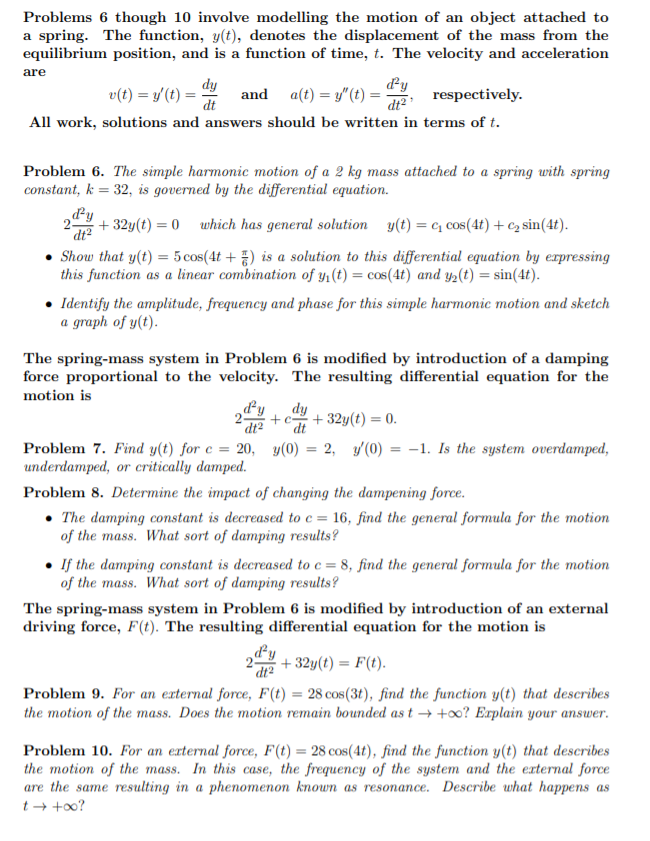Problem 10. For an external force, F(t) = 28 cos(4t), find the function y(t) that describes the motion of the mass. In this case, the frequency of the system and the external force are the same resulting in a phenomenon known as resonance. Describe what happens as t + +o0?
Problem 10. For an external force, F(t) = 28 cos(4t), find the function y(t) that describes the motion of the mass. In this case, the frequency of the system and the external force are the same resulting in a phenomenon known as resonance. Describe what happens as t + +o0?
Advanced Engineering Mathematics
10th Edition
ISBN:9780470458365
Author:Erwin Kreyszig
Publisher:Erwin Kreyszig
Chapter2: Second-order Linear Odes
Section: Chapter Questions
Problem 1RQ
Related questions
Question
Linear Methods
Please answer question number 10

Transcribed Image Text:Problems 6 though 10 involve modelling the motion of an object attached to
a spring. The function, y(t), denotes the displacement of the mass from the
equilibrium position, and is a function of time, t. The velocity and acceleration
are
dy
v(t) = y/(t) =
dt
and a(t) = y"(t) =-
respectively.
dt2
All work, solutions and answers should be written in terms of t.
Problem 6. The simple harmonic motion of a 2 kg mass attached to a spring with spring
constant, k = 32, is governed by the differential equation.
dy
+ 32y(t) = 0
dt2
which has general solution y(t) = c, cos(4t) + c2 sin(4t).
%3D
Show that y(t) = 5 cos(4t +) is a solution to this differential equation by erpressing
this function as a linear combination of y1 (t) = cos(4t) and y2(t) = sin(4t).
• Identify the amplitude, frequency and phase for this simple harmonic motion and sketch
a graph of y(t).
The spring-mass system in Problem 6 is modified by introduction of a damping
force proportional to the velocity. The resulting differential equation for the
motion is
dy
dy
+c+ 32y(t) = 0.
dt2
Problem 7. Find y(t) for e = 20, y(0) = 2, y(0) = -1. Is the system overdamped,
underdamped, or critically damped.
Problem 8. Determine the impact of changing the dampening force.
• The damping constant is decreased to c = 16, find the general formula for the motion
of the mass. What sort of damping results?
If the damping constant is decreased to c = 8, find the general formula for the motion
of the mass. What sort of damping results?
The spring-mass system in Problem 6 is modified by introduction of an external
driving force, F(t). The resulting differential equation for the motion is
dy
+ 32y(t) = F(t).
%3D
dt²
Problem 9. For an external force, F(t) = 28 cos(3t), find the function y(t) that describes
the motion of the mass. Does the motion remain bounded as t → +0? Explain your answer.
Problem 10. For an external force, F(t) = 28 cos(4t), find the function y(t) that describes
the motion of the mass. In this case, the frequency of the system and the external force
are the same resulting in a phenomenon known as resonance. Describe what happens as
t + +o0?
Expert Solution
This question has been solved!
Explore an expertly crafted, step-by-step solution for a thorough understanding of key concepts.
Step by step
Solved in 4 steps with 3 images

Knowledge Booster
Learn more about
Need a deep-dive on the concept behind this application? Look no further. Learn more about this topic, advanced-math and related others by exploring similar questions and additional content below.Recommended textbooks for you

Advanced Engineering Mathematics
Advanced Math
ISBN:
9780470458365
Author:
Erwin Kreyszig
Publisher:
Wiley, John & Sons, Incorporated

Numerical Methods for Engineers
Advanced Math
ISBN:
9780073397924
Author:
Steven C. Chapra Dr., Raymond P. Canale
Publisher:
McGraw-Hill Education

Introductory Mathematics for Engineering Applicat…
Advanced Math
ISBN:
9781118141809
Author:
Nathan Klingbeil
Publisher:
WILEY

Advanced Engineering Mathematics
Advanced Math
ISBN:
9780470458365
Author:
Erwin Kreyszig
Publisher:
Wiley, John & Sons, Incorporated

Numerical Methods for Engineers
Advanced Math
ISBN:
9780073397924
Author:
Steven C. Chapra Dr., Raymond P. Canale
Publisher:
McGraw-Hill Education

Introductory Mathematics for Engineering Applicat…
Advanced Math
ISBN:
9781118141809
Author:
Nathan Klingbeil
Publisher:
WILEY

Mathematics For Machine Technology
Advanced Math
ISBN:
9781337798310
Author:
Peterson, John.
Publisher:
Cengage Learning,

